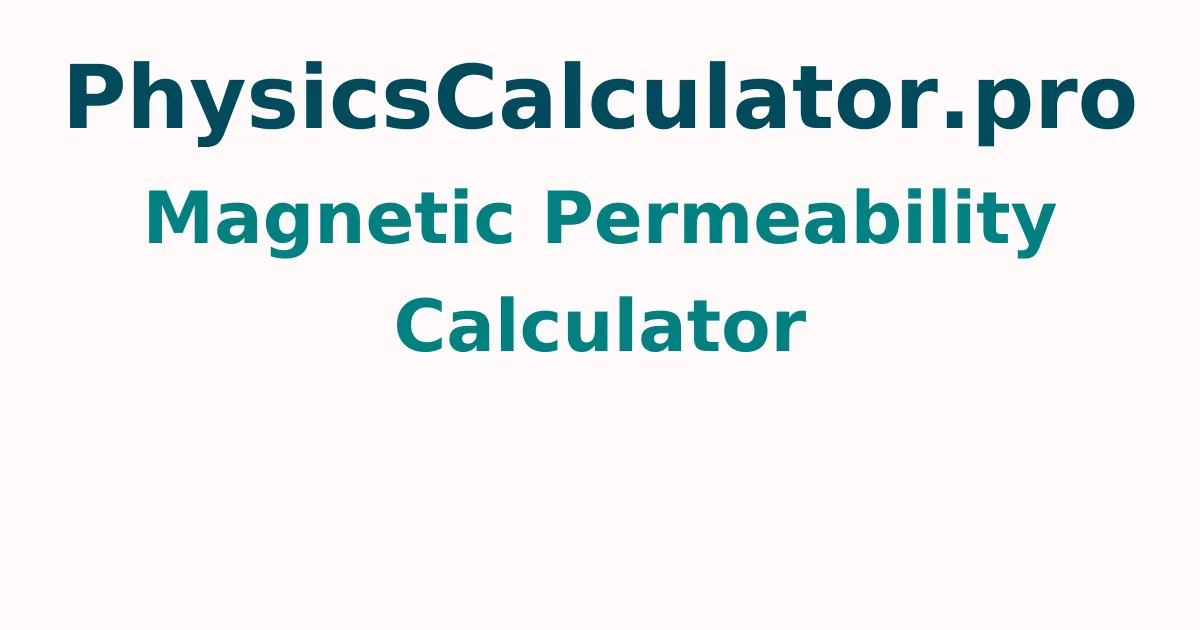Magnetic Permeability Calculator
The online free Magnetic Permeability Calculator application is used to calculate the magnetic permeability and susceptibility of material quickly. Simply input a material or permeability type in the provided input field, then press the calculate button to get relative permeability and magnetic susceptibility results in a microsecond.
Magnetic Permeability and Susceptibility
The magnetic field produced by a material in response to an applied magnetic field is known as permeability. The symbol for magnetic permeability is µ. Diamagnetic materials, paramagnetic materials, and ferromagnetic materials are the three categories of materials.
The magnetic field is defined as the product of the material's permeability and the magnetic field from the outside.
B = µ x H
µ = B/H
B = µ₀ x (H + M)
Magnetization M = χ x H
- Where, M = The magnetic field formed by the substance is known as magnetization.
- H = Outside of the material, there is a magnetic field.
- B = Inside the substance, there is a whole magnetic field.
- Χ = Susceptibility to magnetic fields
- µ = permeability
The magnetic permeability of free space is µ₀ = 4π x 10^-7H/m. The ratio of a substance's permeability to the permeability of free space is known as relative permeability. µr = µ/µo. The following is the relationship between magnetic permeability and susceptibility χ = µ/µo -1 = µr-1
Superconductor
The term "superconductor" refers to a substance with zero permeability and zero electrical resistance. When a material is cooled below its critical temperature, the physical properties of that material change.
How to measure Magnetic Permeability?
Examine the steps for determining magnetic permeability and susceptibility, and then follow them to obtain the results.
- Step 1: Determine the substance's permeability.
- Step 2: To calculate the relative permeability, divide the permeability by the permeability of the free space constant.
- Step 3: To check susceptibility, subtract 1 from the relative permeability.
For more concepts check out physicscalculatorpro.com to get quick answers by using this free tool.
How to Use the Magnetic Permeability Calculator?
The following is the procedure on how to use the Magnetic Permeability calculator
- Step 1: Select the material and enter the permeability in the appropriate input fields.
- Step 2: To acquire the result, click the "Calculate the Unknown" button.
- Step 3: Finally, the output field will show the magnetic permeability and susceptibility of material easily.
Relative Magnetic Permeability Calculation Example
Question 1: Find the relative permeability and susceptibility of a substance with a magnetic permeability of 800 µH/m.
Solution:
Given:
Magnetic permeability of a substance µ = 800 µH/m
Relative permeability µr = µ/µo
= 800/4π x 10^-7
= 636.61
Magnetic susceptibility χ = µr-1
= 636.61 ^-1
= 635.61
Hence, the relative permeability of the substance is 636.61 and susceptibility is 635.61.
FAQs on Magnetic Permeability
1. Is the permeability of permanent magnets high?
When air and vacuum have extremely little mass, the permeability is quite low. On the other hand, Hard magnetic materials have a limited permeability and a lot of mass.
2. What is the magnetic constant of the vacuum?
The magnetic constant 0 (also known as vacuum permeability of free space permeability) is a universal physical constant that connects mechanical and electromagnetic measuring units.
3. Is permittivity affected by frequency?
With increasing frequency, the magnitude of the dielectric permittivity decreases. The dielectric permittivity is constant and real-valued at sufficiently low frequencies.
4. How much work is done on a charged particle inside a magnetic field by a magnetic force?
The kinetic energy and speed of a charged particle in a magnetic field are constant because the magnetic field does not do any work. Circular motion will be caused by the magnetic force, which acts perpendicular to the particle's velocity.
